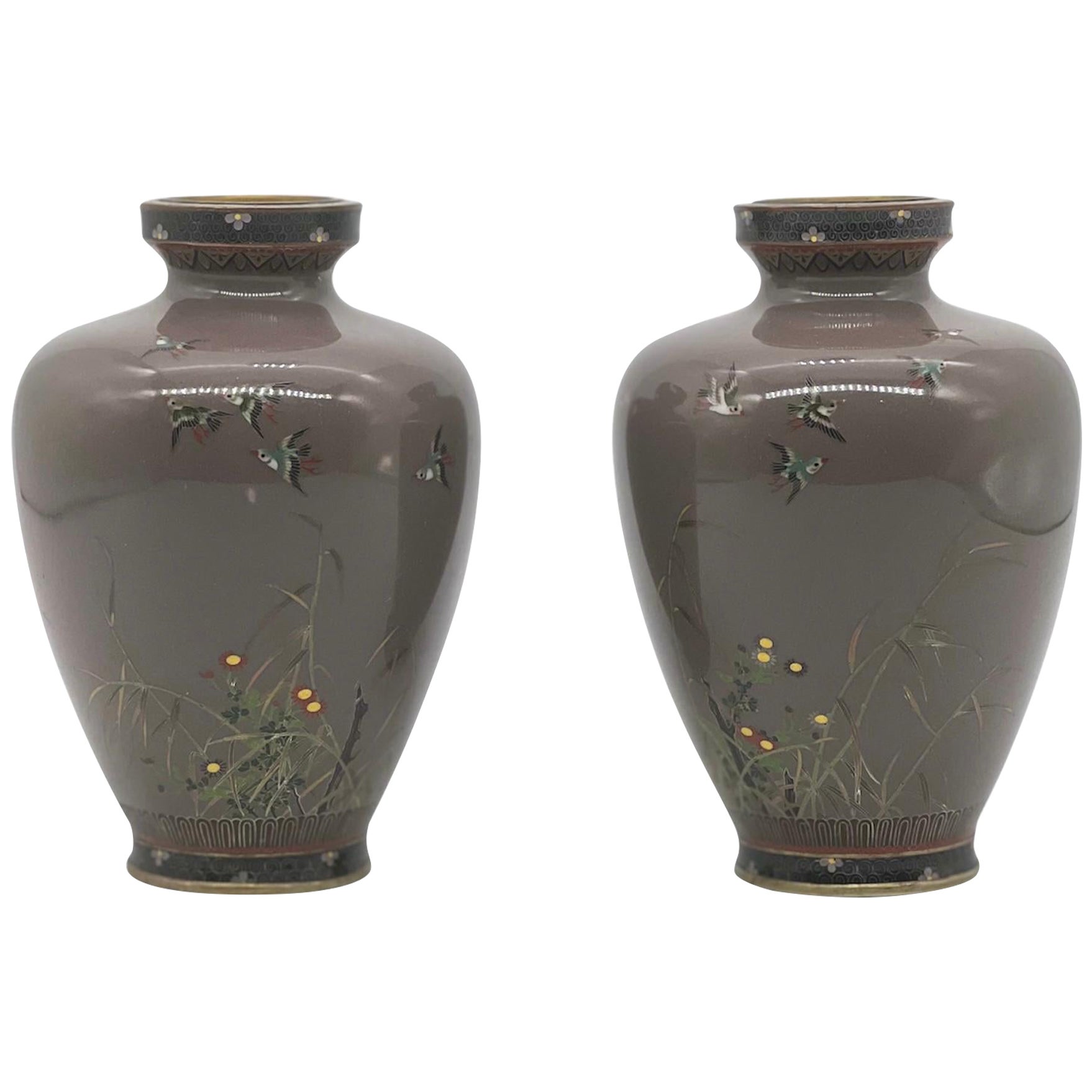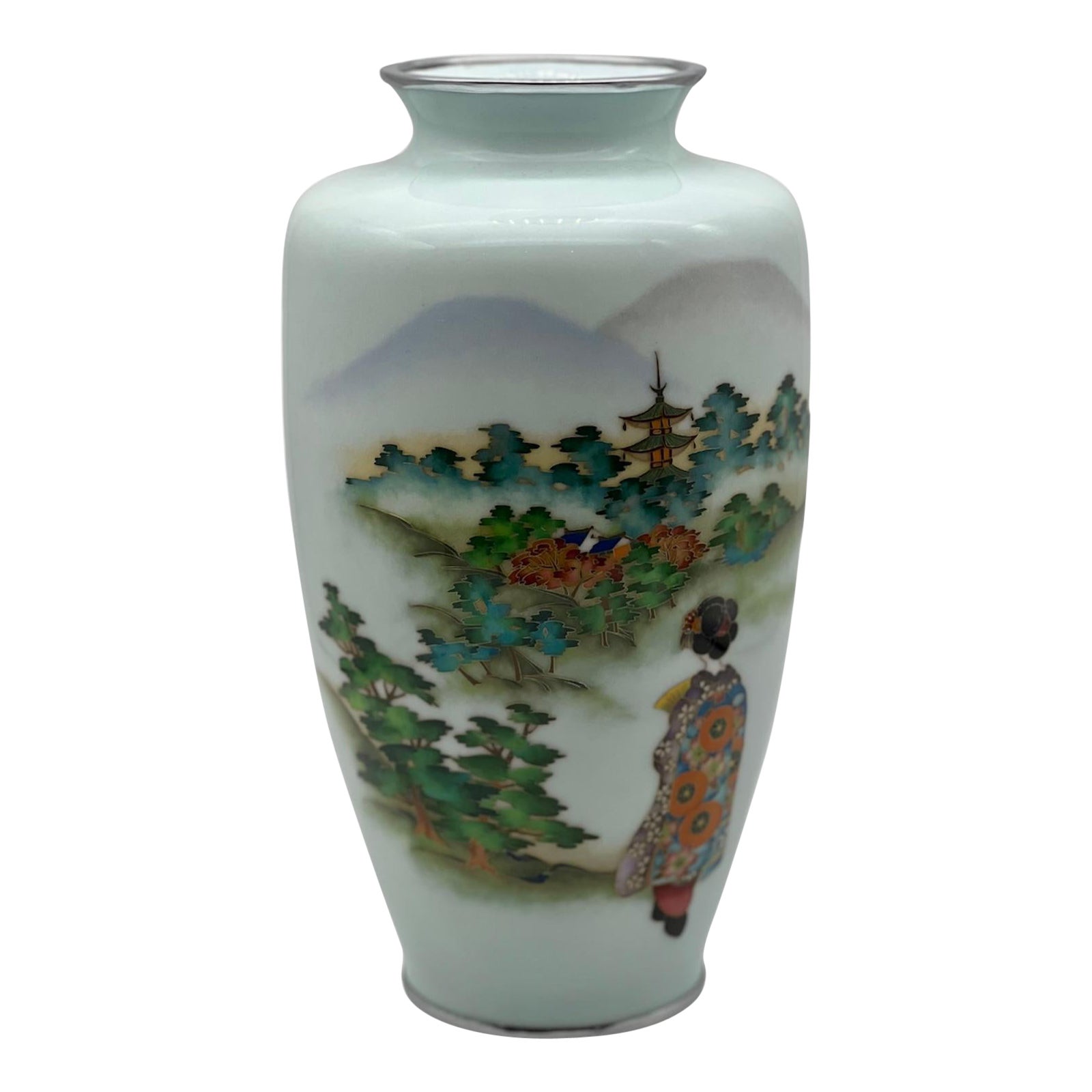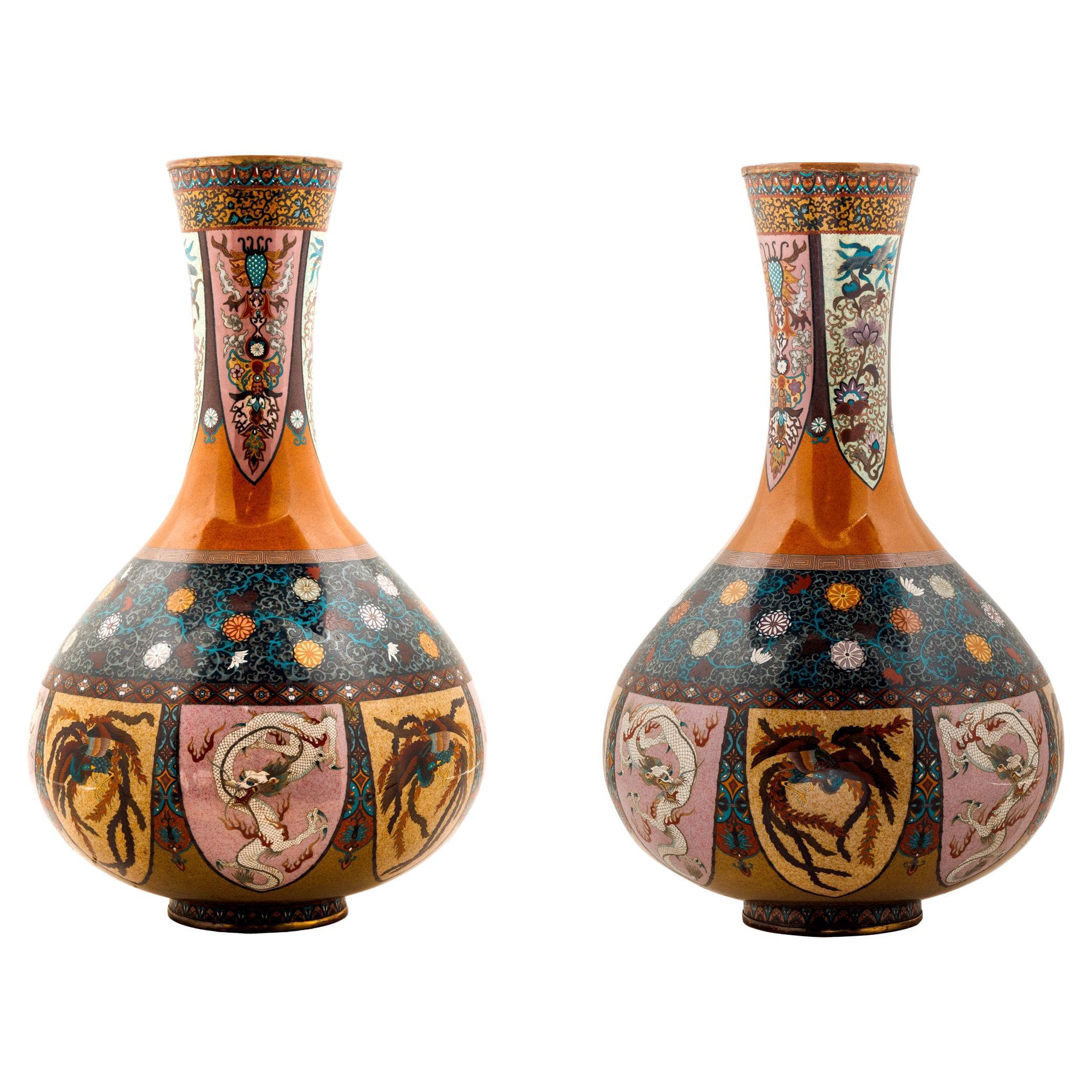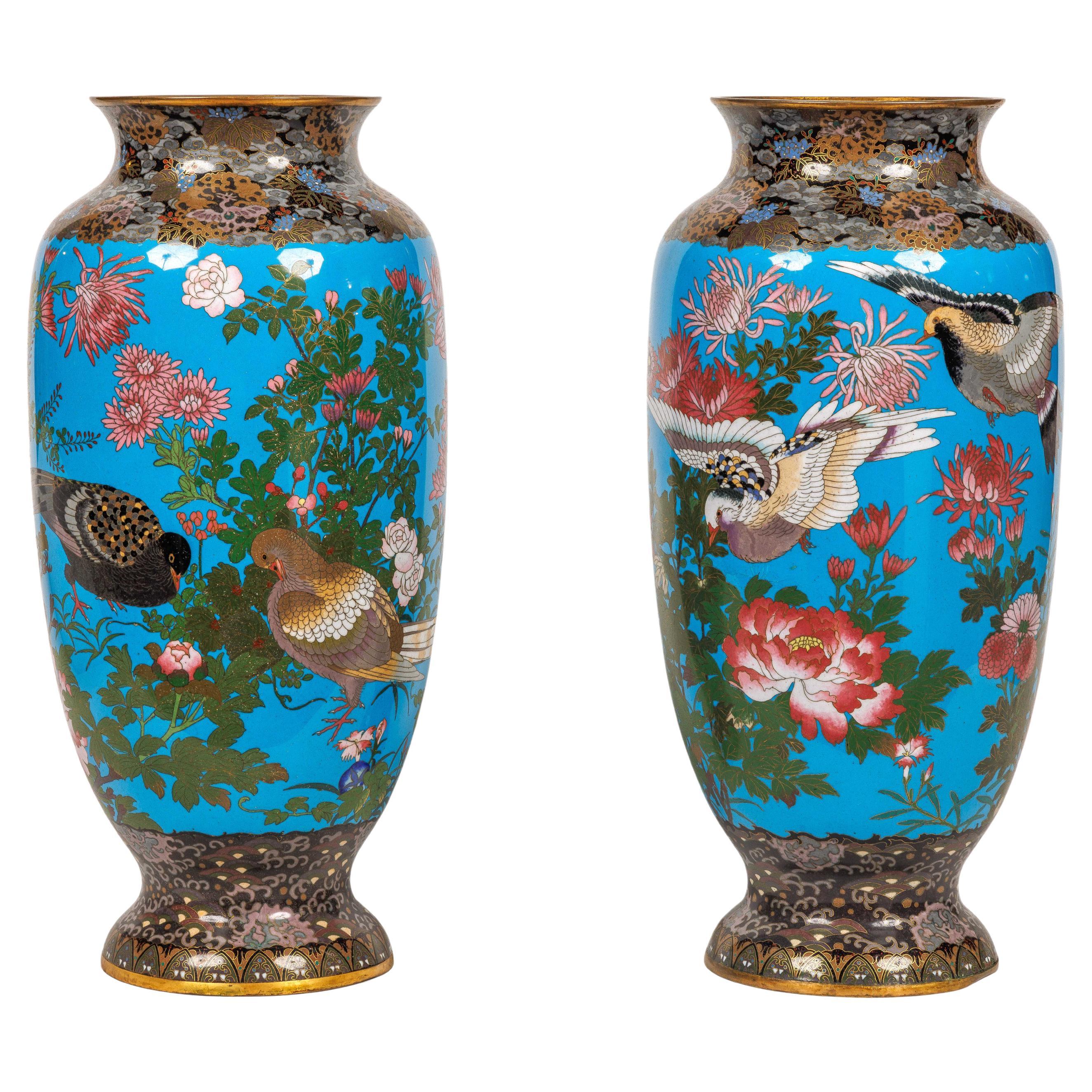Items Similar to Fine Japanese Cloisonné-enamel and Musen Vase Attributed to Namikawa Sosuke
Want more images or videos?
Request additional images or videos from the seller
1 of 19
Fine Japanese Cloisonné-enamel and Musen Vase Attributed to Namikawa Sosuke
About the Item
A magnificent Cloisonné-enamel and Musen Baluster vase attributed to Namikawa Sosuke.
Meiji era (1868-1912), late 19th century.
This vase features an elegant classic form with a slender neck and flared mouth above a baluster body. Decorated with three egrets wading among reeds growing in a pond, reserved on a ground gradually changing from pink to pale blue, applied with a brass rim and silver foot; the egrets worked in white musen (wireless) enamel plumage, their beaks and eyes subtly highlighted in silver wire.
Size: height-28 cm, wide-11 cm, diameter to the bottom 7 cm.
In excellent condition.
The similar Namikawa Sosuke vase sold in Bonhams, London -Japanese Art Across the centuries. November 2022.
A truly masterpiece from Namikawa Sosuke workshop.
Namikawa Sosuke (1847–1910) was a Japanese cloisonné artist, known for innovations that developed cloisonné enamel into an artistic medium sharing many features with paintings. He and Namikawa Yasuyuki (no relation) were the most famous cloisonné artists of the 1890 to 1910 period, known as the "golden age" of Japanese enamels. Around 1880 he set up and ran the Tokyo branch of the Nagoya Cloisonné Company. He exhibited his artworks at national and international expositions, where he took an organising role.
He was recognised as an Imperial Household Artist and created art works for imperial residences.
- Dimensions:Height: 11.03 in (28 cm)Width: 4.34 in (11 cm)Depth: 11.03 in (28 cm)
- Materials and Techniques:
- Place of Origin:
- Period:
- Date of Manufacture:circa 1890
- Condition:Wear consistent with age and use.
- Seller Location:London, GB
- Reference Number:
About the Seller
No Reviews Yet
Vetted Seller
These experienced sellers undergo a comprehensive evaluation by our team of in-house experts.
Established in 2001
1stDibs seller since 2023
5 sales on 1stDibs
- ShippingRetrieving quote...Ships From: London, United Kingdom
- Return PolicyA return for this item may be initiated within 7 days of delivery.
More From This SellerView All
- A Fine Pair of Japanese Cloisonne Enamel Vases Attributed to Hayashi KodenjiLocated in London, GBA Exquisite Pair of Japanese Cloisonne Enamel Vases Attributed to Hayashi Kodenji. Meiji period 19th Century A Fine Pair of Japanese cloisonné ename...Category
Antique Late 19th Century Japanese Metalwork
MaterialsEnamel
- A Large Japanese Cloisonne Enamel vase attributed to Ando JubeiBy Ando JubeiLocated in London, GBA Large Japanese Cloisonne Enamel vase attributed to Ando Jubei. Taisho period (1912 – 1926) A large baluster Cloisonne-Enamel vase worked in musen and silver wire of varying gauge...Category
Early 20th Century Japanese Metalwork
MaterialsEnamel
- A Fine Japanese Cloisonne Enamel Vase and Cover. Meiji PeriodLocated in London, GBA Exquisite Cloisonne Enamel Vase and cover Meiji period -Late 19th C Exquisite and refined four sided cloisonne vase and cover made in gold and silver wire with dragons and phoen...Category
Antique Late 19th Century Japanese Metalwork
MaterialsEnamel
- Exquisite Cloisonné Enamel Vase and Cover in the Manner of Namikawa YasuyukiLocated in London, GBA Exquisite Cloisonné enamel vase and cover in the Manner of Namikawa Yasuyuki . Meiji period. A 19th century Japanese cloisonne lidded vase and...Category
Antique Late 19th Century Metalwork
MaterialsEnamel
- Fine Japanese Kyoto Shippo Cloisonne Enamel Vase, 19th CLocated in London, GBA fine Japanese Kyoto Shippo Cloisonne enamel vase 19th C Meiji Period JAPANESE CLOISONNE ENAMEL VASE,?decorated with cranes and butterflies amongst lotus and iris blooms reser...Category
Antique Mid-19th Century Metalwork
MaterialsEnamel
- A Fine Opposing Pair of Japanese Cloisonne Enamel Vases. 19th CLocated in London, GBA Fine Opposing Pair of Japanese Cloisonne Enamel Vases. 19th Century. OPPOSING PAIR OF JAPANESE CLOISONNE ENAMEL VASES, Meiji Period (1868-1912), worke...Category
Antique Late 19th Century Japanese Metalwork
MaterialsEnamel
You May Also Like
- Large Pair of Japanese Cloisonne Enamel Vases Attributed to Honda YasaburoLocated in New York, NYA large pair of Japanese Cloisonne Enamel vases attributed to Honda Yasaburo, 19th century. Finley decorated with the rich enamel colors of orange and green, these vases are desig...Category
Antique 19th Century Japanese Meiji Metalwork
MaterialsCopper, Enamel
- Large Pair of Meiji Period Japanese Cloisonne Enamel Vases Attributed to GotoLocated in New York, NYA large pair of Meiji Period Japanese cloisonne enamel vases attributed to Goto Seizaburo, 19th century. These vases were made during the Meiji period (1868-1912) in Japan and are...Category
Antique 19th Century Japanese Meiji Metalwork
MaterialsCopper, Enamel
- Fine Japanese Cloisonne Enamel Vase – Namikawa YasuyukiLocated in Christchurch, GBAs part of our Japanese works of art collection we are delighted to offer this fine quality Meiji Period (1868-1912) cloisonne enamel vase manufactured by the Imperial artist Namikawa Yasuyuki...Category
Antique 19th Century Japanese Meiji Metalwork
MaterialsSilver, Enamel, Wire
- Large Pair of Japanese Cloisonne Enamel Lanterns Attributed to Kaji TsunekichiLocated in New York, NYA Large Pair of Japanese Cloisonne Enamel Lanterns Attributed to Kaji Tsunekichi, Edo Period, 19th century Japanese cloisonne lanterns were made during the Meiji period, from the late 19th to early 20th century, and were often used as decorative lighting fixtures in temples and shrines. Kaji Tsunekichi (1866-1916) was a Japanese cloisonné artist who was active in the late 19th and early 20th centuries. He was born in Tokyo and learned the art of cloisonné from his father, Kaji Sataro, who was also a cloisonné artist. He was renowned for his mastery of the shippo-yaki technique, which involves creating intricate designs with thin wires on a metal base before filling in the spaces with enamel. Tsunekichi was known for his exceptional technical skills and his ability to create intricate designs with vibrant colors. His works often featured nature motifs, such as flowers, birds, and fish, which were rendered in a highly detailed and naturalistic style. He also experimented with new techniques, such as plique-à-jour, a type of cloisonné that creates a stained-glass effect. Tsunekichi's works were highly prized during his lifetime and continue to be sought after by collectors today. He won numerous awards for his cloisonné creations, including a Gold Medal at the 1900 Exposition Universelle in Paris. His works are characterized by their fine wirework, precise enamel application, and attention to detail. Some of Tsunekichi's most famous works include a pair of large cloisonné vases...Category
Antique 19th Century Japanese Edo Metalwork
MaterialsCopper, Enamel
- Japanese Cloisonne Enamel Vase Ando CompanyBy Ando JubeiLocated in Newark, EnglandJapanese cloisonne enamel vase. The vase of ovoid form with circular opening, black enamel glaze and silver mounted rims. Boldly decorated with autumnal flowers and birds. To the top and bottom geometric patterns finish the vase. Notes Ando Cloisonné...Category
Early 20th Century Japanese Meiji Metalwork
MaterialsMetal, Silver, Enamel
- Japanese Cloisonne Enamel Vase – Namikawa YasuyukiLocated in Christchurch, GBAs part of our Japanese works of art collection we are delighted to offer this striking Meiji Period 1868-1912, cloisonne enamel vase by the Imperial artist Namikawa Yasuyuki...Category
Antique 19th Century Japanese Meiji Metalwork
MaterialsSilver, Enamel
Recently Viewed
View AllMore Ways To Browse
Shelf 1830
Ercole Barovier Vintage
Scroll Arm Rest
Venetian Glass Shade
Thonet Chair Signed
Popular Vases Set
Antique Beveled Mirror Gold
Table Lanterns In Brass
Murano Glass Leaf Patterns
Desktop Writing Desk
Verner Panton Series
Vintage Italian Floor Lamp 1950
Iron Garden Set Woodard
Painted Large Ceramic Lamp
Pair Of Side Buffets
Pair Of Three Drawer Wood Chests
George Iv Sterling
Oval Wood Table With Leaves





